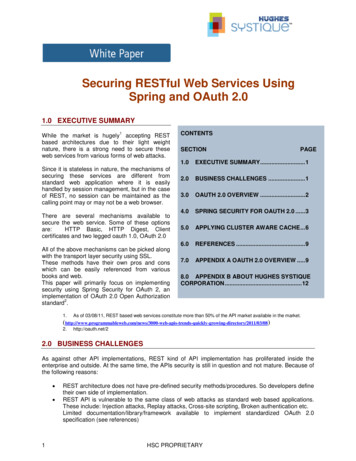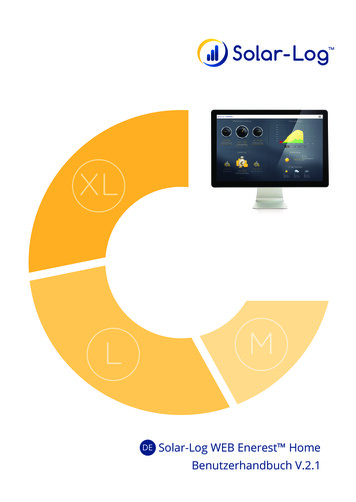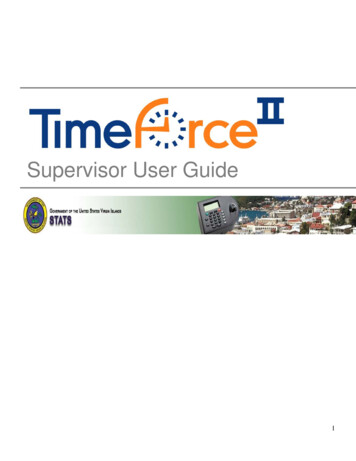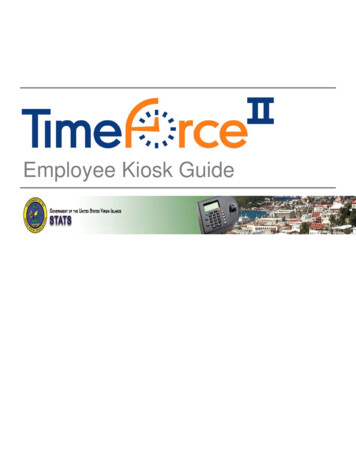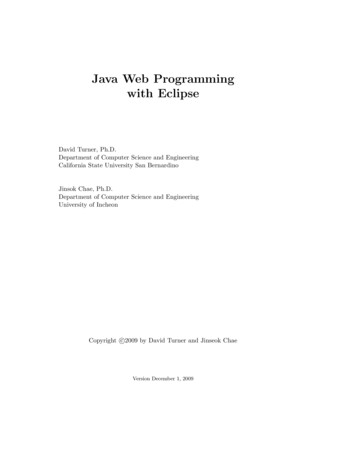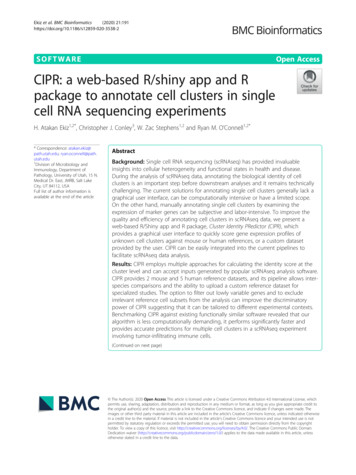
Transcription
Ekiz et al. BMC Bioinformatics(2020) TWAREOpen AccessCIPR: a web-based R/shiny app and Rpackage to annotate cell clusters in singlecell RNA sequencing experimentsH. Atakan Ekiz1,2*, Christopher J. Conley3, W. Zac Stephens1,2 and Ryan M. O’Connell1,2** Correspondence: atakan.ekiz@path.utah.edu; ryan.oconnell@path.utah.edu1Division of Microbiology andImmunology, Department ofPathology, University of Utah, 15 N.Medical Dr. East, JMRB, Salt LakeCity, UT 84112, USAFull list of author information isavailable at the end of the articleAbstractBackground: Single cell RNA sequencing (scRNAseq) has provided invaluableinsights into cellular heterogeneity and functional states in health and disease.During the analysis of scRNAseq data, annotating the biological identity of cellclusters is an important step before downstream analyses and it remains technicallychallenging. The current solutions for annotating single cell clusters generally lack agraphical user interface, can be computationally intensive or have a limited scope.On the other hand, manually annotating single cell clusters by examining theexpression of marker genes can be subjective and labor-intensive. To improve thequality and efficiency of annotating cell clusters in scRNAseq data, we present aweb-based R/Shiny app and R package, Cluster Identity PRedictor (CIPR), whichprovides a graphical user interface to quickly score gene expression profiles ofunknown cell clusters against mouse or human references, or a custom datasetprovided by the user. CIPR can be easily integrated into the current pipelines tofacilitate scRNAseq data analysis.Results: CIPR employs multiple approaches for calculating the identity score at thecluster level and can accept inputs generated by popular scRNAseq analysis software.CIPR provides 2 mouse and 5 human reference datasets, and its pipeline allows interspecies comparisons and the ability to upload a custom reference dataset forspecialized studies. The option to filter out lowly variable genes and to excludeirrelevant reference cell subsets from the analysis can improve the discriminatorypower of CIPR suggesting that it can be tailored to different experimental contexts.Benchmarking CIPR against existing functionally similar software revealed that ouralgorithm is less computationally demanding, it performs significantly faster andprovides accurate predictions for multiple cell clusters in a scRNAseq experimentinvolving tumor-infiltrating immune cells.(Continued on next page) The Author(s). 2020 Open Access This article is licensed under a Creative Commons Attribution 4.0 International License, whichpermits use, sharing, adaptation, distribution and reproduction in any medium or format, as long as you give appropriate credit tothe original author(s) and the source, provide a link to the Creative Commons licence, and indicate if changes were made. Theimages or other third party material in this article are included in the article's Creative Commons licence, unless indicated otherwisein a credit line to the material. If material is not included in the article's Creative Commons licence and your intended use is notpermitted by statutory regulation or exceeds the permitted use, you will need to obtain permission directly from the copyrightholder. To view a copy of this licence, visit http://creativecommons.org/licenses/by/4.0/. The Creative Commons Public DomainDedication waiver ) applies to the data made available in this article, unlessotherwise stated in a credit line to the data.
Ekiz et al. BMC Bioinformatics(2020) 21:191(Continued from previous page)Conclusions: CIPR facilitates scRNAseq data analysis by annotating unknown cellclusters in an objective and efficient manner. Platform independence owing to Shinyframework and the requirement for a minimal programming experience allows thissoftware to be used by researchers from different backgrounds. CIPR can accuratelypredict the identity of a variety of cell clusters and can be used in variousexperimental contexts across a broad spectrum of research areas.Keywords: Single cell RNA-sequencing, Cluster analysis, Identity prediction, Similarity,Gene expression profiling, Immune cellsBackgroundSingle cell RNA sequencing (scRNAseq) has enabled researchers to interrogate cellularphenotypes at an unprecedented resolution and led to the discovery of several new biological phenomena [1]. This new tool has gained significant traction in numerous research areas including immunology, developmental and cancer biology, and is beingcontinually improved in terms of the technology and analytical pipelines. Data fromscRNAseq is typically analyzed via various unsupervised clustering approaches resultingin distinct groups of cells defined by similar gene expression profiles [2]. DuringscRNAseq data analysis, it is advantageous to relate single cell clusters to known celltypes before proceeding to downstream steps such as differential expression analysesand data visualization. In the past 2 years, an increasing number of software solutionsto automatically classify cell clusters in scRNAseq data have been reported [3–13]. Recent studies provided a rigorous assessment of these methods in terms of performanceand accuracy, and found that no one tool is perfectly suitable for every experimentalcontext [14–16]. These tools can be computationally intensive, and they generally lacka graphical user interface limiting their use in iterative analyses. Furthermore, thesetools may not be easily adaptable to different experimental contexts and, in some cases,the learning curve can be difficult to those with limited coding experience due to specialized data structures. Thus, many researchers still rely on manually examiningknown marker genes to determine the cluster identity in scRNAseq experiments. However, manual annotation of cell clusters is labor-intensive and requires field-specific expert biological knowledge. Additionally, this approach can be subjective and difficult toreproduce. Therefore, there is a need for a fast and accurate classification algorithmthat can be easily integrated into existing analytical pipelines.To facilitate identifying cell clusters in scRNAseq data, here we present Cluster Identity PRedictor (CIPR) (pronounced cy-per), a web-based R/Shiny application and Rpackage which scores complex multi-gene expression signatures of unknown experimental cell clusters against known reference cell populations. After calculating identityscores between unknown clusters-reference pairs, the pipeline generates informativegraphical outputs allowing the users to easily assess predictions. CIPR pipeline can beused with one of the 7 preloaded mouse and human reference datasets, or with a userprovided custom reference dataset for specialized studies. CIPR algorithm performs internal gene name matching in a species-agnostic manner enabling comparisons acrossspecies. Users can exclude irrelevant reference cell subsets and lowly variable genesfrom the analysis and adapt the CIPR pipeline to their experimental needs. Our analyses using scRNAseq data obtained from mouse melanoma tumor-infiltrating immunePage 2 of 15
Ekiz et al. BMC Bioinformatics(2020) 21:191Page 3 of 15cells show that CIPR can accurately and efficiently predict the identity of single cellclusters and can be used to annotate immune cell subsets. Benchmarking CIPR against2 robust software solutions performing a similar task, SingleR [12] and scmap [13], revealed that CIPR produces comparable results while requiring significantly less compute resources and a shorter runtime. Thus, CIPR can facilitate scRNAseq data analysisby quickly and accurately annotating unknown cell clusters.ImplementationSummary of the pipelineSoftware is implemented using R programming language and Shiny framework. CIPR isaccessible via online Shinyapps.io server [17], or as a stand-alone R package [18]. Theopen source code for the Shiny application and the R package is available on GitHub[18, 19]. CIPR can work with two types of experimental input data commonly generated by popular scRNAseq analysis software: i) a data frame containing differentiallyexpressed genes per cluster and their log fold-change (logFC) values, ii) a summarydata frame that contains average normalized log-counts per gene in each cluster (for allgenes in the dataset). As the reference, CIPR allows users to select one of the 7 preloaded reference datasets (Table 1) or upload a custom reference dataset generated byTable 1 Summary of the reference datasets included in CIPRReference datasetSpeciesNumber of Number of Reference cell typessamples/cell typesfeatures(main/fine)RefImmunological Genome M.296/24197 20/296Project (ImmGen)musculusB cell, Baso, DC, Eosino, gd-T, Gran,ILC-1, ILC-2, ILC-3, Mac, Mast, Mono,NK, NKT, Pre-B, Pre-T, Stem-Prog,Stromal, T cell, Treg[20]Presorted cell RNAseq(various tissues)M.358/21214 18/28musculusAdipocyte, Astrocyte, B cell,Cardiomyocyte, DC, Endothelial,Epithelial, Erythrocyte, Fibroblast,Gran, Hepatocyte, Mac, Microglia,Mono, Neuron, NK, Oligodendrocyte,T cell[21]Blueprint/ENCODEH.sapiens259/19859 24/43Adipocytes, B cell, T cell, Chondrocyte,DC, Endothelial, Eosino, Epithelial,Erythrocyte, Fibroblast, HSC, Keratinocyte,Mac, Melanocyte, Mesangial, Mono,Myocyte, Neuron, Neutro, NK cells,Pericyte, Skeletal muscle, Smooth muscle[22,23]Human PrimaryCell AtlasH.sapiens713/19363 37/157Astrocyte, B cell, BM, Prog, Chondrocyte,CMP, DC, ESC, Endothelial, Epithelial,Erythroblast, Fibroblast, Gametocyte,GMP, Hepatocyte, HSC, iPS, Keratinocyte,Mac, MEP, Mono, MSC, Myelocyte,Neuroepithelial, Neuron, Neutro, NK,Osteoblast, Platelet, Pre/Pro-B, Smoothmuscle, T cell, Tissue SC[24]Database of ImmuneCell Expression (DICE)H.sapiens15*/57,773 5/15CD4 T cell, CD8 T cell, NK cell, B 211/13276 17/38B cell, Baso, CD4 T cell, CD8 T cell,[26]CMPs, DC, Eosino, Erythroid, GMP, Gran,HSC, Megakaryocyte, MEP, Mono, NK, NKTPresorted cell RNAseq(PBMC)H.sapiens114/46077 11/29B cells, Baso, CD4 T cell, CD8 T cell, DC, [27]Mono, Neutro, NK cells, Prog, T cell
Ekiz et al. BMC Bioinformatics(2020) 21:191various high throughput analysis approaches including microarray and RNAseq. Depending on the input type, CIPR can either compare the logFC values of differentiallyexpressed genes in clusters against reference comparators (where a logFC value at individual gene level is calculated for each reference cell subset in comparison to the average expression across the entire reference dataset), or calculate correlations using theentire gene set. The algorithm computes a vector of identity scores through pairwisecomparisons of clusters and reference samples, generates visualizations and allowsdownloading the results as a csv file. In the CIPR R package implementation, the pipeline functions as described above with added functionality to control the graphical andnumerical output.Table 1 Multiple reference datasets are available within the CIPR pipeline. These include 2 reference datasets from mouse and 5 reference datasets from human, whichcontain data from both immune and non-immune cells. ImmGen reference was prepared from raw microarray data (both v1 and v2 ImmGen releases). DICE referencelog-transformed transcript-per-million data was downloaded from DICE database directly. Log-normalized counts for other references were obtained from SingleR package.Reference data frames were organized for CIPR pipeline using the code accessible atGitHub repository [19]. Abbreviations: Baso, basophil; Eosino, eosinophil; gd-T,gamma-delta T; Gran, granulocyte; ILC, innate lymphoid cells; Mac, macrophages;Mono, monocytes; NK, natural killer; Treg, regulatory T cells; Prog, progenitor; DC,dendritic cells; Neutro, neutrophil; H/M/E/SC, hematopoietic/mesenchymal/embryonicstem cells; MEP, megakaryocyte erythrocyte progenitor; CMP, common myeloid progenitor; GMP, granulocyte-macrophage progenitor; iPS, induced pluripotent stem cell.*Although the DICE reference data is originally composed of 1561 samples, to reducecompute time and generate readable outputs, we utilized mean transcript-per-milliondata per cell type resulting in 15 averaged samples).Use case scenario: melanoma tumor infiltrating lymphocyte scRNAseq dataWe have recently described immune cell dynamics during murine melanoma tumorgrowth in vivo [28]. In this study, CD45 flow cytometry-sorted immune cells were sequenced via the 10X Genomics platform followed by computational analysis using SeuratR package [29]. Our analysis revealed 15 distinct single cell clusters within the tumormicroenvironment (Fig. 1a). To demonstrate the capabilities of CIPR, here we focus onclusters 05 and 15 which distinctly expressed the marker genes defining natural killer(NK) cell and plasmacytoid dendritic cell (pDC) lineages, respectively (Fig. 1b, c) [30, 31].Using Seurat, we performed differential expression analyses at the cluster level and usedthis as the input for CIPR’s recommended logFC dot product method (see below for comparisons of different CIPR methods). In this analysis, we used Immunological GenomeProject (ImmGen) reference which contains microarray data from sorted mouse immunecells (296 samples from 20 main cell types) [20]. CIPR calculates a distinct identity scorefor each unknown cluster-reference pair resulting in 296 calculations per cluster. The results for individual clusters are shown in scatter plots where data points correspond to theidentity score calculated for a specific reference cell subset (plotted in the x-axis) (Fig. 1d,e). The color-coded data points help users distinguish the enrichment of identity scores inparticular reference cell types at a glance. To help assessing the quality of CIPRPage 4 of 15
Ekiz et al. BMC Bioinformatics(2020) 21:191Fig. 1 CIPR provides a R/Shiny-powered graphical user interface to facilitate cluster annotation in scRNAseqexperiments. a T-distributed stochastic neighbor embedding (t-SNE) plot for the example scRNAseq dataderived from murine melanoma tumor infiltrating lymphocytes shows 15 distinct immune cell clusterswithin the tumor microenvironment (the dataset contains 13,985 features and 11,054 cells) [28]. Todemonstrate the capabilities of CIPR we focus on clusters 05 and 15 which distinctly expressed (b) naturalkiller cell (NK) and (c) plasmacytoid dendritic cell (pDC) markers respectively. d We used the CIPR pipelineto score the gene expression profiles of cluster 15 (pDC) against 296 mouse immune cells found in theImmGen reference. CIPR algorithm calculates a distinct identity score for each reference cell type andgenerates a graphical summary of the results. In these plots, 4 highest data points (red rectangle)correspond to pDC samples within the ImmGen reference. The shaded regions in the graphs delineate 1and 2 standard deviations around the mean identity score calculated from the entire reference data frame.Data points are color-coded based on the reference cell type allowing an easy assessment of the results. eThe CIPR results for cluster 05 (NK cells) is shown. Marked data points depict the NK cells in the ImmGendataset that had the highest identity scores. Users can visualize graphs for each cluster separately and havethe option of further manipulating the plots if the R package implementation of CIPR is used. f CIPR canalso generate graphical outputs to summarize the 5 top-scoring reference samples for each experimentalcluster. The scatter plot shows the pDC and NK cell subsets that had the highest scores for clusters 05 and15. In Shiny implementation of CIPR, users can draw rectangles around these points to prompt a tableoutput which provides further information about the reference cell types on the graphpredictions, the algorithm outputs shaded regions in the scatter plots that mark theboundaries of 1 and 2 standard deviations of the identity score across the reference dataframe. Furthermore, we implemented a z-score approach where the distance of the identity score for a particular reference cell type is calculated in standard deviation units fromthe average identity score across the whole reference dataset. As the identity- and z-scorecalculations are impacted by the composition of the input/reference data and the analysisparameters, it is difficult to define a widely applicable significance threshold for the predictions. In our hands, predictions with z-scores higher than 1 were consistent with expertknowledge-based manual annotations. In CIPR, we chose not to leave the low/intermediate-scoring clusters unlabeled since, even though the cluster in analysis may not have aperfect match in the reference subset, knowing which reference cell subset it resemblesPage 5 of 15
Ekiz et al. BMC Bioinformatics(2020) 21:191the most is informative, especially when performing iterative analyses. Indeed, recentstudies show that analytical pipelines which implement an “unassigned” classification donot have an overall improvement in prediction accuracy [14, 16]. Thus, we anticipate thatthe graphical outputs of CIPR will provide a convenient and visual means to assess thestrength of predictions in individual studies. In our experimental data, as expected, cluster15 was strongly predicted to be a pDC subset as evidenced by the 4 blue-colored datapoints which were well above the rest of the reference subsets (Fig. 1d). Cluster 05 scoredthe highest with the NK cell subsets which are depicted by pink-colored data points (Fig.1e). Although these scatter plots are informative, the user may only want to see the topscoring reference datasets for each cluster. CIPR pipeline also generates a summary output in which only the 5 highest-scoring reference cell types are plotted per cluster (Fig.1f). In the Shiny implementation of CIPR, users can draw a rectangle around these pointswhich will prompt a table output below the figure providing further details about the reference cell types. The summary and per-cluster graphical outputs are created under distinct tabs in the CIPR-Shiny to speed up the user interaction and to create a minimalistinterface. Users can choose to suppress one or both of these plots in the CIPR R packageto tailor pipeline for programmatical use.Results and discussionDifferent computational approaches in CIPRSelecting the genes or features that have higher discriminatory potential is a criticalstep in automated cluster classification algorithms. Some computational pipelines perform feature selection automatically, while others allow custom feature selection orproceed to analysis with no pre-filtering. Machine-learning based feature selection canimprove algorithmic predictions, but it can also increase the demand for computing resources depending on the number of cells in the analysis, as reported by Zhao et al.[16] and Huang et al. [15]. In CIPR, we implemented two main computational approaches to calculate identity scores: i) analysis using data only from the differentiallyexpressed genes in clusters, ii) analysis using the entire gene set (no feature selection).Our experience suggests that the genes with the least discriminatory power will be naturally filtered out in the first case, leaving the most informative genes that can betterdistinguish the cell clusters from one another in the analysis. The CIPR algorithm cancompare the logFC values of differentially expressed genes in experimental clusterswith the logFC values of the matching genes in the reference dataset (calculated by taking the ratio of gene expression in the reference subset to the average expression valueacross the entire reference data frame) by using one of three methods: i) dot product,ii) Spearman’s correlation, iii) Pearson’s correlation. We recommend using the logFCdot product method as it factors in both the direction and the amount of differentialexpression for a given gene. For instance, if a gene is highly upregulated or downregulated in the unknown cluster and in the specific reference sample, the multiplication ofsuch logFC values will contribute to the overall identity score, while the genes showinga strong anti-correlation will proportionately reduce the identity score. CIPR can alsotest the linear and nonlinear relationships between the logFC values from the unknowncluster and the reference dataset using Spearman’s or Pearson’s respectively. Alternatively, CIPR pipeline can also assess the nonlinear and linear correlations between thePage 6 of 15
Ekiz et al. BMC Bioinformatics(2020) 21:191input and reference datasets by considering all genes regardless of differential expression status.We sought to determine how these different analytical approaches compare to therecommended logFC dot product method. As expected, all three logFC comparisonmethods showed a high degree of concordance for both clusters 05 (NK cells) and 15(pDCs) (Fig. 2a, b). When we examined the z-score distribution for these methods, weobserved a similar trend with slightly higher z-scores for top hits when the logFC dotFig. 2 Different analytical methods implemented in CIPR performs comparably to annotate single cellclusters. Three of the analytical methods in CIPR (logFC dot product, logFC Spearman’s or Pearson’scorrelation) utilizes only differentially expressed genes in clusters. The recommended approach in CIPR islogFC dot product method since it takes both the direction and the amount of differential expression intoaccount when calculating identity scores per cluster. The other approaches in CIPR are designed to analyzethe expression profiles of all the genes in the experimental data regardless of their differential expressionstatus. This figure compares the predictions of the logFC dot product method to other analyticalapproaches in CIPR. Data points in the scatter plots indicate the identity score of individual ImmGenreference cell subsets calculated for clusters 05 and 15 by different methods. As expected, there is a strongcorrelation between the results of logFC dot product method and (a) logFC Spearman’s and (b) logFCPearson’s correlation methods for both clusters. c, d The same strong correlation was observed when the zscores were compared for these methods, although logFC dot product differentiated the highest scoringreference subsets slightly better as evidenced by a higher z-score. The results of (e) all-genes Spearman’sand (f) all-genes Pearson’s methods show an overall positive correlation with those from logFC dot productmethod, although logFC dot product approach was able to better differentiate the top-scoring referencesubsets as evidenced by higher z-scores shown in panels g and h. Similar observations were made forother clusters in the experimental dataset but are not shown due to space constraintsPage 7 of 15
Ekiz et al. BMC Bioinformatics(2020) 21:191product method is used (Fig. 2c, d). We then compared the logFC dot product methodwith the correlation methods that utilize the entire gene set (all-genes Spearman/Pearson methods). Although the CIPR identity scores between these approaches showed anoverall positive correlation, this relationship was weaker at the low/intermediate-scoring reference subsets suggesting that logFC dot product method may have a higher discriminatory power compared to the all-genes correlation-based methods (Fig. 2e, f). Asexpected, since the reference data set and the experimental data originated from different experimental approaches, Pearson’s correlation performed poorer compared toSpearman’s method (Fig. 2g, h). Nevertheless, we anticipate that the all-genes Pearson’smethod can be useful in some experimental contexts with custom-provided referencedatasets. Similar trends were observed when other clusters in the scRNAseq datasetwere examined (data not shown). These findings suggest that different computationalapproaches implemented in CIPR generates converging results and can be adapted tovarious experimental contexts.CIPR performs faster than other robust cluster annotation methods and producescomparable resultsAs reported by recent studies, automated cluster annotation algorithms SingleR [12]and scmap [13] perform robustly in various experimental contexts and simulations[14–16]. Scmap was initially developed for mapping different scRNAseq runs to oneanother, while SingleR allows using both bulk RNAseq and scRNAseq data as reference.SingleR calculates a Spearman’s correlation coefficient between single cell clusters andthe reference samples after selecting variable features within the data frame [12]. Scmapmethod also performs unsupervised feature selection and scores the similarity of singlecells to reference clusters by comparing its gene expression to the median expressionwithin the reference dataset (13). As these solutions are conceptually similar to our approach and were shown to be accurate in their predictions, we next sought to determine how CIPR compares to these pipelines in terms of its predictions andperformance. To be able to perform a fair comparison with CIPR, we adapted scmappipeline to use ImmGen bulk microarray data as reference. The latest versions of CIPR(v0.1.0), SingleR (v.1.0.5) and scmap (v1.8.0) that were available for the most currentstable release of R (v3.6.2) were used in benchmarking at the time of this writing. Asthe CIPR calculations are performed at the cluster level, we employed the same strategyfor SingleR and scmap analyses. As expected, CIPR’s all-genes correlation methodshowed a strong concordance with SingleR method which also employs a correlationbased metric to calculate identity scores (Fig. 3a). LogFC methods showed a significantoverall positive correlation between CIPR and SingleR. The highest scoring referencesamples were similar between all three methods in general. This was especially clearwhen analyzing the highly differentiated cell types such as NK cells (cluster 05), pDCs(cluster 15), and activated CD8 T cells (cluster 02). Scmap did not find a significantassociation between naïve CD8 T cell subset (cluster 03) and the referencedataset although naïve T cell subsets are present in the ImmGen reference data. However, the lack of a cell type assignment in this cluster and overall low scores observedusing the scmap method, could be due to suboptimal feature selection when scmap isrun with a bulk reference data (personal communication, Dr. Martin Hemberg, thePage 8 of 15
Ekiz et al. BMC Bioinformatics(2020) 21:191Fig. 3 CIPR performs faster than other cluster analysis approaches and produces comparable results. aSingleR and scmap are recently described R packages for automated cluster analysis which can performanalyses at the cluster level similarly to the CIPR approach. These algorithms were shown to perform well invarious experimental contexts and can serve as a high benchmark for automated cluster analysis solutions.By performing all the analyses at the cluster level, here we report a comparison of CIPR R package (v.0.1.0),SingleR (v1.0.5) and scmap (v1.8.0) in terms of predictions and performance. For these comparisons, aSurface Pro4 computer equipped with 64-bit Win7, 16 GB memory, 2.2GHz i7-6650U CPU, R (v.3.6.2), andRStudio (v.1.2.5033) was used with no other background processes. a Five analytical methods implementedin CIPR were compared to SingleR and scmap across 5 individual clusters. Data points indicate the identityscores calculated for each ImmGen reference cell subset by different methods. Color gradient specifies theidentity score calculated by scmap method (gray indicates no significant mappings were found). Asexpected, CIPR’s all-gene Spearman’s/Pearson’s methods are highly concordant with SingleR pipeline. Theresults from CIPR logFC methods show an overall positive correlation with SingleR, where the highestscoring reference cell types in CIPR were similar to those calculated by SingleR and scmap. In some cases,scmap failed to find a significant association which may be due to its suboptimal power when a bulkreference data is used as input. b CIPR performs significantly faster than SingleR, and comparably to scmapin 5 separate tests. We benchmarked the runtime of SingleR function both with and without fine tuningfeature. Scmap (short) measures the runtime of scmapcluster computational engine, whereas scmap (long)measures the runtime starting with the initial object creation. c CIPR utilizes less computer memory overtime compared to (d) SingleR (no fine tuning) and (e) scmapPage 9 of 15
Ekiz et al. BMC Bioinformatics(2020) 21:191author of scmap package). The high concordance between CIPR and other establishedmethods suggest that the CIPR algorithm provides accurate classifications across a variety of cell types.When we compared the runtimes of these methods, we observed that CIPR was significantly faster compared to SingleR with or without SingleR’s “fine tuning” parameter(Fig. 3b). Scmap had a similar speed with CIPR when only the identity prediction function is measured (labeled “scmap-short”) and had a slightly longer runtime when thetime it takes to set up the analysis object is considered (labeled “scmap-long”, whichwould be a comparable use scenario to CIPR). However, we anticipate longer computing times from scmap pipeline when high dimensional scRNAseq data is used insteadof the bulk reference data in current analyses (as per scmap design). We next assessedthe memory utilization by these methods. All CIPR methods utilized less than 1000megabytes (Mb) of memory (Fig. 3c), whereas SingleR required 1500 Mb without finetuning and over 6000 Mb with fine tuning (Fig. 3d). Scmap used comparable amountsof memory for computations but required 5000–6000 Mb of memory to set up the analysis object (Fig. 3e). These observations suggest that the CIPR algorithm can performcluster-level identity predictions in an accurate and efficient manner to facilitatescRNAseq data analysis.
Software is implemented using R programming language and Shiny framework. CIPR is accessible via online Shinyapps.io server [17], or as a stand-alone R package [18]. The open source code for the Shiny application and the R package is available on GitHub [18, 19]. CIPR can work

